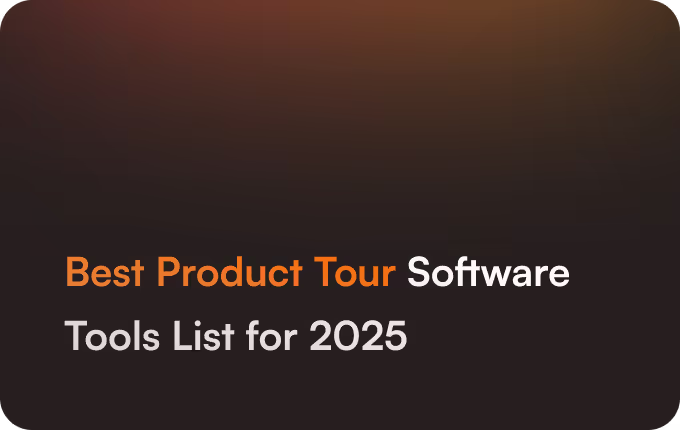
Experts share: Common mistakes Product Managers Do & Why it Harms Onboarding Success



User onboarding acts as the gateway to a seamless user experience —a bridge connecting users to the heart of a product's functionality.
However, product managers often encounter missteps that inadvertently jam this gateway, obstructing the smooth flow of user adoption.
This article will lean into the knowledge and experience of Jamie McDermott, B2B SaaS onboarding expert and Founder of Flow Agency. He will share the most common problems he sees his clients encounter during the user onboarding creation process-- and how to avoid them.
This article is a collaboration between Product Fruits and Flow Agency.
1. The struggle of the “everything-at-once” approach
In the pursuit of providing comprehensive user onboarding, product managers often fall into the trap of trying to fit every aspect of their product within the initial flow.
They get lost in the idea they need to do all the onboarding flow in one sweep, instead of taking a step back and learning from users, behavior, and what works.
While the intention is noble—to showcase the full array of features and functionalities—this approach commonly leads to a cluttered and overwhelming onboarding experience.
By creating content, adding onboarding elements, and building a fixed flow all in one go, you lose the chance to learn and adapt.
Jamie shares, “Often, there’s a struggle with the idea that they can't do it all at once. So they'll say: Well, we've done a load of digging into our data, and we've realized that users are doing this or they want this, or they don't want this. So we need to build this really complex system.”
But that's exactly the opposite of what needs to be done. Users need one goal, one feature, one flow to hit their "aha moment"
But as Jamie notes, “We need the onboarding process to be really simple. Now we need to go back to basics and start small, so I think that probably one of the big ones is trying to convince people to start small. Start small in the individual experiences, and also start small in their approach.”
Crafting an effective onboarding flow requires an agile approach, involving testing, iteration, and refinement based on user feedback and analytics.
You can’t expect to build a full onboarding flow in one day -- and it’s not a failure to take smaller steps in the approach.
This is because a streamlined onboarding flow that introduces fundamental features gradually. A gradual approach allows users to build their understanding progressively. This also includes the need to prioritize the most critical functionalities through a user-centric approach to onboarding that enhances comprehension, engagement, and overall user satisfaction in the long run.
Solution: Take small, but mighty steps
Start small in the individual experiences. By slowly showing pieces of the product, and also starting small in their approach to creating an onboarding flow.
Jamie advises to “Break down the onboarding flow into smaller, manageable steps and set a focused and user-friendly experience. Prioritizing the most crucial features and information in each step allows users to digest information gradually and comfortably. It also provides the opportunity to evaluate user responses and iterate on each step for enhanced effectiveness.”

Product managers need to resist the urge to overwhelm users with an exhaustive onboarding experience. Instead, focus on the essential elements that enable users to grasp the core value proposition and start using the product effectively is key.
The aim is to strike a balance between offering valuable information and maintaining simplicity. Users need to feel empowered and encouraged to explore further functionalities as they become more familiar with the product, rather than bombarded with an information overload right from the start.
2. Governed by insufficient or meaningless data
Data should be the ultimate decision-maker when it comes to any user onboarding practices. However, the problem arises when data is murky or insufficient, which leaves room for blurry decisions.
One common mistake is to make assumptions about user behavior without concrete data to back them up.
Product managers might create onboarding flows based on internal perspectives or personal assumptions rather than relying on thorough user research or analytics. This can lead to onboarding experiences that don't align with the actual needs or behaviors of the target users.
The problem is not only with insufficient data, but as Jamie puts it, “Or data that’s just a bit meaningless. For example, data might tell you what a user does or doesn't do, but how does that inform you about which feature you should be using in a product onboarding?”
The problem with meaningless data, as Jamie puts it, “Sometimes you try to force an onboarding feature to a problem, but murky data means they end up not really aligned.”
Moreover, incomplete or inaccurate data can result in misguided decisions during the implementation of onboarding strategies.
If product managers rely on incomplete user feedback or outdated analytics, they miss out on crucial insights into user preferences, pain points, or usage patterns. This can lead to ineffective onboarding experiences that fail to resonate with users.
Solution: Be intentional with your data
To overcome these challenges, prioritize comprehensive data collection and analysis throughout the onboarding design and implementation phases.
This includes user analytics, conducting user interviews, surveys, and usability testing to gather meaningful insights into user behavior and preferences.
Regularly updating and refining the onboarding flow based on real-time user feedback and data analytics is crucial. This iterative approach allows product managers to adapt the onboarding experience to better align with user needs, making sure that it remains relevant and effective.
By leveraging accurate and updated data, product managers can design onboarding experiences that are tailored to the specific needs of their users, leading to higher user satisfaction, improved retention rates, and increased overall product success.
With Product Fruits, you can use our analytics to understand the onboarding behavior of your users easily. Or, you can integrate it with your preferred data management platform.

3. Not willing to try– and learn
A common mistake is fearing the risk of trying something new. Oftentimes, clients will be stuck trying to replicate what other companies are doing with the idea that “Hey, it works for them, it’ll work for us”.
The truth is, as Jamie says “There is nothing that you can learn from another business because chances of the same goal are very limited. For example, everyone looks at Miro… and I'm like don't look at Miro. They are one of two software platforms in the world that do what they do and have the brand that they do”.
Jamie advocates the thought that, if you’ve done the research and have an idea that hasn’t been tested -- you need to fully commit to that idea.
Don’t be scared to try an onboarding flow that goes outside the box -- there is no one-size-fits-all strategy, nor is there a perfect way.
The best way to grow is to continuously invest in the small experiences and then optimize from user feedback.

4. Ignoring foundational work and research
User onboarding flows need to be intentional. To learn, grow, and optimize, there needs to be a “why” behind every decision. And that “why” is often discovered through research.
If no research is conducted, all onboarding creation efforts are, well… meaningless and directionless.
You risk spending time, resources, and money on an onboarding flow that does not have a backbone of research to understand priorities and onboarding goals.
Similar to the common mistake of trying to do everything at once, Jamie says, “Research doesn't have to be perfect, but do that little bit of research. Do competitor research to understand what your competitors are doing.”
Fix: Dig deep into research and audits
Your research will be the foundation to guide your user onboarding choices and strategy plans. The understanding from research will help validate and commit to efforts, as well as give a clear direction to tasks.
As Jamie puts it, “Do that audit, identify those things. Because, if you're sitting in a meeting and someone goes; ‘why did we X?” You can have a backup and say, “We did this because the research showed us Y, and this was one of three routes we could have taken. We tried route one, but it didn't work, we're now trying route two, if it's not working; we've got route three”.
Use audits to understand the current process, and the steps that need to be taken to improve towards the final flow.
And, bonus points if you can talk to your customers. Jamie reinforces, “We do speak to people when we need to and have to, and we encourage our clients to go and do that separately, as well. We also ask them to go and do research customer-led sort of customer information, fact-finding experiments”
And especially if you work in a niche market, Jamie recommends, “If you’re industry leaders in a new niche market, you've got a lot more learning to do on the side of the customer to understand the value so just be prepared to make mistakes”.

5. Keeping teams in silo is an onboarding buzz-kill
When departments are kept separate from conversations about onboarding, you risk losing valuable knowledge of your team’s expertise and skill set to create the perfect onboarding journey.
Think of it this way:
- Your sales team might have insight into the exact value that brings users to convert on demo calls that could help accelerate “aha” moments
- Your customer success teams understands your users common struggles and painpoints
- Your marketing team understands how to promote and communicate your products value
- Your development team has the expertise to adapt features to meet the feedback of users
Each department can bring their skills and knowledge to the table to make sure users get the best experience.
Of course, as Jamie notes, “I think it very much so depends on the size of the business very But yeah, sales and marketing absolutely need to feed into it. It should be an experience.”
Fix: Invite everyone to the onboarding table
Prioritize open communication and collaboration when it comes to onboarding planning. That way, all departments feel empowered to share their ideas and feedback.
Jamie shares his own experience with a team that faced silo efforts and communication “I had a call with a client recently where we did a brainstorming session for onboarding and we built their checklist.
At that point, creating the checklist was being governed by the team who can't really say what their users need -- because really, only the user can say what they need. However, we don't have access to all those users and all that data.
So, the next best thing is getting the whole team involved, and asking them what they hear from their users. We got all the customer success, sales, and marketing people -- and it was really interesting.
When we tallied up what everyone thought would be the best approach, sense checked it, and one of the things that had the smallest number of votes was included as the number one priority because we decided a user must see this first to reach the goal”

6. Relying too heavily on AI
Yes, AI is a super tool to supercharge all your tasks and complete them in half the time. And the truth is, if you aren’t using AI tools, you are behind the competition.
But ( and its a very important but) AI tools should not overshadow a human's expertise.
And relying too heavily on AI tools means you miss out on the right directions, A/b tests, and out-of-the-box strategies.
Jamie shares his thoughts, ”Yes, some AI to help generate some ideas and to format things in different ways. But I think the downside is that quite simply, if you give AI to someone and say " there you go, it doesn't teach them how to think onboarding. It only enables them to do onboarding.”
People can get lost in the fancy tools, and forget the “why”. But these incredible tools can help businesses achieve their goals, but it doesn't do it for them and they still have to do that groundwork."
Think of it this way:
"Humans are the “why”, and AI tools are the “how”.
Fix: Be the puppeteer of AI
When creating user onboarding tools, you can quickly fall into the trap of letting onboarding tools carry all the weight. But, you still need a puppeteer to direct onboarding decisions and efforts.
When working with AI, Jamie recommends, “Think about experiences, map them out, and build them. So sometimes these kinds of solutions can distract people from what the challenge really is. You've solved the biggest challenge, which was how to deploy these experiences quickly, effectively, and cost-effectively. But, actually, are you still going to do that other work”
Yes. Use AI to build user onboarding flows. But, use customer feedback, competitor research, data, and out-the-box and user-centered design to strategize the user experience from A-to-Z.
With Product Fruits, we empower you to do just that. Our AI-powered user onboarding removes the hassle of the first draft of an onboarding flo, and instead generates beautiful flows with a couple of clicks.

The right tool and strategy are the keys to reach user onboarding goals
Your user onboarding strategy is only as good as the tool you use.
With Product Fruits, you get the full toolbox of onboarding and product adoption features equipped with customer rules and user segmentation. The best part? No coding is required.
And, the best onboarding tool is only as effective as the strategy behind each flow. That’s where a PLG approach makes a difference.
Are you looking to drastically reduce churn and drive user activation? Book a call with Jamie and take advantage of the wealth of knowledge and expertise to find the best approach to your user onboarding needs.



























